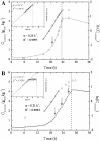Genome-wide expression analysis upon constitutive activation of the HacA bZIP transcription factor in Aspergillus niger reveals a coordinated cellular response to counteract ER stress
- PMID: 22846479
- PMCID: PMC3472299
- DOI: 10.1186/1471-2164-13-350
Genome-wide expression analysis upon constitutive activation of the HacA bZIP transcription factor in Aspergillus niger reveals a coordinated cellular response to counteract ER stress
Abstract
Background: HacA/Xbp1 is a conserved bZIP transcription factor in eukaryotic cells which regulates gene expression in response to various forms of secretion stress and as part of secretory cell differentiation. In the present study, we replaced the endogenous hacA gene of an Aspergillus niger strain with a gene encoding a constitutively active form of the HacA transcription factor (HacACA). The impact of constitutive HacA activity during exponential growth was explored in bioreactor controlled cultures using transcriptomic analysis to identify affected genes and processes.
Results: Transcription profiles for the wild-type strain (HacAWT) and the HacACA strain were obtained using Affymetrix GeneChip analysis of three replicate batch cultures of each strain. In addition to the well known HacA targets such as the ER resident foldases and chaperones, GO enrichment analysis revealed up-regulation of genes involved in protein glycosylation, phospholipid biosynthesis, intracellular protein transport, exocytosis and protein complex assembly in the HacACA mutant. Biological processes over-represented in the down-regulated genes include those belonging to central metabolic pathways, translation and transcription. A remarkable transcriptional response in the HacACA strain was the down-regulation of the AmyR transcription factor and its target genes.
Conclusions: The results indicate that the constitutive activation of the HacA leads to a coordinated regulation of the folding and secretion capacity of the cell, but with consequences on growth and fungal physiology to reduce secretion stress.
Figures







References
-
- Jeenes DJ, Mackenzie DA, Roberts IN, Archer DB. Heterologous protein production by filamentous fungi. Biotechnol Genet Eng Rev. 1991;9:327–367. - PubMed
MeSH terms
Substances
Grants and funding
LinkOut - more resources
Full Text Sources
Molecular Biology Databases

